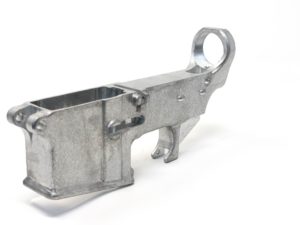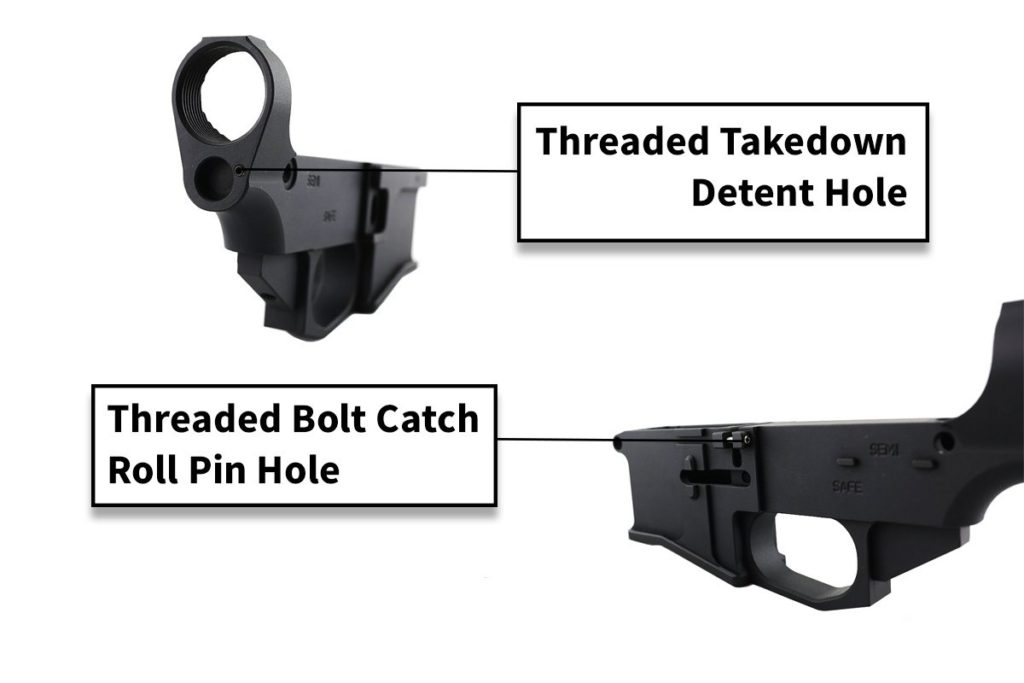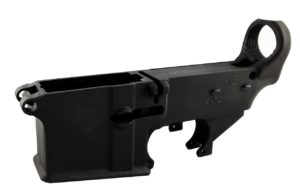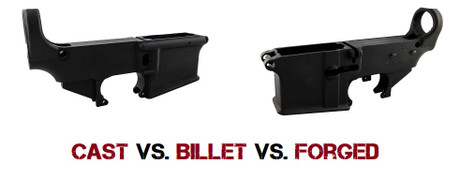Cast vs. Billet 6061-T6 vs. Forged 7075-T6
Posted by Gun Builders Depot on Apr 16th 2018
While researching what parts to purchase for your custom AR-15 build, you're no doubt going to find references to '6061 vs 7075 aluminum.'
Aluminum has always been popular in the world of AR-15 parts. Due to its ease of fabrication, strength and corrosion resistance, most AR parts are machined from either 6061 or 7075 series aluminum. Some units are also made from cast A380 aluminum, which we'll review in this guide as well. In the world of metallurgy, aluminum is given a numerical identifier that refers to its properties. When referring to aluminum, the alloys that make up a particular series of aluminum can make a difference in its strength and performance. (Hence the debate between 6061 vs 7075 aluminum.)
So, what's the difference between the two? Is a cast 80 lower receiver even worth it? Let's find out.
6061 vs 7075 Aluminum
While there are a host of opinions regarding AR parts manufactured from 6061 and 7075 aluminum, our aim is to remain objective and informative. Here are the facts regarding these two series of aluminum.
Composition
While the alloys that make up 6061 and 7075 are similar, the actual amount of material making up each alloy is significantly different.
The composition of 6061 aluminum includes magnesium, silicon, iron, copper, zinc, titanium, manganese, and chromium.
The composition of 7075 aluminum consists of the same alloys but differs in the amounts of magnesium, silicon, iron, copper, zinc, titanium, manganese, and chromium, and additional trace elements.
For additional details and exact percentages, please view the following resources. We also detail the chemical composition of each alloy when comparing receivers below.
6061 - https://asm.matweb.com/search/SpecificMaterial.asp?bassnum=MA6061t6
7075 - https://asm.matweb.com/search/SpecificMaterial.asp?bassnum=MA7075T6
Key Properties
In the 6061 vs 7075 aluminum debate, it's important to remember that the key properties of both types of aluminum are what make them ideal for a variety of AR parts.
- The properties of 6061 aluminum include corrosion resistance, weldability, medium to high strength, and good workability.
- The properties of 7075 aluminum are high strength, stress resistant, workability and improved stress-corrosion resistance.
Although 7075 aluminum does offer some additional strength over its 6061 counterpart, this does not mean 6061 is inadequate for most AR-15 applications.
Strength
Some AR-15 aficionados would declare 7075 to be superior when choosing between 6061 vs 7075 aluminum. This belief is due to the mechanical properties of 7075 aluminum.
Although the mechanical properties do differ between 6061 and 7075 aluminum, remember your AR-15 will most likely never be subjected to the extreme PSI's listed in the following data.
6061 - Mechanical Properties
- Tensile strength: 276 MPa (40,000 PSI)
- Fatigue strength: 96.5 MPa (14,000 PSI)
- Shear strength: 207 MPa (30,000 PSI)
- Hardness: 95 (Brinell Scale)
- Machinability: 50%
7075 - Mechanical Properties
- Tensile strength: 503 MPa (73,100 PSI)
- Fatigue strength: 159 MPa (23,000 PSI)
- Shear strength: 331 MPa (48,000 PSI)
- Hardness: 150 (Brinell Scale)
- Machinability: 70%
Difference
When it comes down to the final straw of the 6061 vs 7075 aluminum discussion — its personal preference. While some may prefer 7075 aluminum, others will recognize the value of 6061.
Cast vs. Billet vs. Forged 80 Lower Receivers
Cast Aluminum Lower Receiver (A380)

Casting aluminum usually refers to the method of forming a lower receiver by using a formed mold. By pouring molten aluminum into a ""lower-shaped"" mold, the receiver blank is formed as the molten alloy solidifies. The cast lower is then removed and a CNC machine is used to clean up seams, file down edges, and finish the manufacturing process.
Physical Properties
- Tensile strength: 159 MPa (23,100 PSI)
- Fatigue strength: 138 MPa (20,000 PSI)
- Shear strength: 185 MPa (26,800 PSI)
- Hardness: 80 (Brinell Scale)
Composition (%, Range or Max)
- Aluminum: 80.3-89.5
- Copper: 3.0-4.0
- Iron: 1.3
- Magnesium: 0.1
- Manganese: 0.5
- Nickel: 0.5
- Silicon: 7.5-9.5
- Tin: 0.35
- Zinc: 3.0
Pros
- Extremely affordable
- Easy to manufacture
Casting offers a functional, economic 80% lower. Because there are very few moving parts and steps required to make a cast lower, they're usually the least expensive of the choices. This process can also offer a great combination of mechanical properties when A380 aluminum is used during the casting process.
Cons
- Brittle, prone to cracking
- Potentially unsafe
- Difficult to anodize
A properly cast lower receiver will get the job done, but many shooters and machinists have commented on their frailty, especially compared to forged or billet lowers. Cast A380 aluminum is hard, but naturally brittle. It doesn't do a good job of absorbing energy from direct impacts, and it has a much higher chance of suffering from fissures, cracks, or other imperfections that might compromise the integrity of the receiver. Both these qualities make a cast lower a generally poorer choice for your black rifle or pistol (especially if it's a 9mm operated by blow-back).
Anodizing cast A380 aluminum also requires a special process involving submersing it in nitric acid and ammonium bifluoride. This dissolves silicon that's built up on the surface of the metal during the cast process, exposing the raw aluminum underneath for anodizing. Because of this, shooters usually choose to coat cast lowers with a painted finish instead.
Billet Aluminum Lower Receiver (6061 T6)

The billet aluminum lower is made by literally cutting it out from a large piece of 6061 aluminum bar stock, then cleaning it up with a CNC machine to achieve the final shape. Think of billet receivers as being made in a ""cookie cutter"" sort of way. Bar stock is a large, industrial piece of billet aluminum that's been forced into its final shape (usually a long solid tube or rectangular bar) through extrusion.
Composition (%)
- Aluminum: 95.8-98.6
- Chromium: 0.04-0.35
- Copper: 0.15-0.4
- Iron: 0.7
- Magnesium: 0.8-1.2
- Manganese: 0.15
- Silicon: 0.4-0.8
- Titanium: 0.15
- Zinc: 0.25
Pros
- Manufacturing produces a strong, lightweight receiver
- Incredibly resistant to corrosion and surface wear
- Can be cut to complex shapes with unique fittings and features
- Cutting/drilling billet aluminum wears out tool bits slower than a forged lower
The extrusion process forces the raw bar stock through large hydraulic rollers under immense heat and pressure. Extruding the billet aluminum like this elongates the grain structure of the metal, giving it increased mechanical strength. Billet aluminum lowers are also the "nicest looking" of the three types of lowers. Because the CNC machines used to cut them are able to mill fine lines and complex designs, billet lowers are known for their aesthetics. While looks do little for overall performance, some like the added finesse when building a custom AR.
Cons
- Most expensive of the three receiver types
- Surface is softer than forged or cast receivers
Because billet lowers require so much fabrication, they typically cost more than cast or forged receivers. Cast and forged receivers typically exhibit greater surface hardness, making the billet receiver more prone to suffering blemishes from dings and impacts.
Forged Aluminum Lower Receiver (7075 T6)

Forged aluminum receivers are made by literally hammering raw aluminum into the final shape of the receiver. Special forging dies are installed atop large, hydraulic hammers to shape the aluminum. The metal is subjected to repeated compression and heat by the hammers, improving its mechanical properties and general "toughness". Once the forging is complete, the roughly shaped receiver needs to be further cut and polished up by CNC machining, much like a cast lower.
Composition (%, Range or Max)
- Aluminum: 87.1-91.4
- Chromium: 0.18-0.28
- Copper: 1.2-2.0
- Iron: 0.5
- Magnesium: 2.1-2.9
- Manganese: 0.3
- Silicon: 0.4
- Titanium: 0.2
- Zinc: 5.1-6.1
Pros
- The strongest aluminum lower available
- Most resistant to direct impacts and wear
- Easier to machine than billet or cast aluminum
A forged lower receiver is the strongest of all lowers. Surprisingly, it's also the easiest to cut and drill. Metallurgists agree that the forging process results in the aluminum having continuous grain characteristics with incredible density and uniformity. It is also this consistency in the metal's structure that makes cutting and drilling a forged unit easier and less prone to tooling issues than a billet or cast unit.
Cons
- None
Forged lowers are generally considered "the best" of the three choices. A forged receiver is tougher, harder, easier to complete, and less expensive than a cast or billet aluminum option.
T6 Aluminum Tempering (6061 & 7075)
AR-15 receivers aren't just made regular 6061 or 7075-series aluminum. They're made from 6061-T6 or 7075-T6. But what is the T6? The ""T"" means temper, and the ""6"" refers to which kind of temper the aluminum alloy has been subjected to. This extra tempering process is incredibly important for the sake of the receiver. Tempering the aluminum gives billet and forged lowers the strength they need to withstand the extreme pressures created inside the chamber when a round is fired.
A T6 temper involves heat treatment, quenching, and artificial aging.
Sounds pretty complex, but the process is simple: Once created, the raw 6061 or 7075 aluminum is heated to 990 degrees (F) for one hour and then dipped in water to cool it off, known as quenching. The heating process dissolves all the alloy's elements (magnesium, zing, silicon, etc.) into a uniform ""solid solution"" in the aluminum. This forms an ordered array of atoms in the aluminum, strengthening the aluminum considerably.
Quenching is not done to further strengthen the metal like conventional blacksmithing, although it does strengthen it slightly. Instead, the rapid cooling effect of quenching ensures the diffused alloy elements don't ""precipitate"" (seep out) of the heated metal while cooling. Once cooled, the metal is then artificially aged by heating it a second time to 350 degrees (F) for approximately 8 hours. This enhances the typical yield strength of the entire receiver from 8,000 PSI to 35,000 PSI.
Yield strength is the real, working strength of the metal. This is, how much force it can take before it permanently deforms, bends, and cracks.
Summary
Is there a right or wrong choice when purchasing an 80 percent lower receiver? Yes and no. A cast lower from a reputable company will be the least expensive receiver type, and it'll suit most AR builders just fine. A forged 80% receiver is also affordable and basically bomb-proof. Billet receivers cost more, but they come with more features and better looks.
Ultimately, it's your personal preference (though a forged lower is technically the best).
DISCLAIMER: If you are new to the world of DIY gun building, you likely have a lot of questions and rightfully so. It’s an area that has a lot of questions that, without the correct answers, could have some serious implications. At GunBuilders.com, we are by no means providing this content on our website to serve as legal advice or legal counsel. We encourage each and every builder to perform their own research around their respective State laws as well as educating themselves on the Federal laws. When performing your own research, please be sure that you are getting your information from a reliable source.

